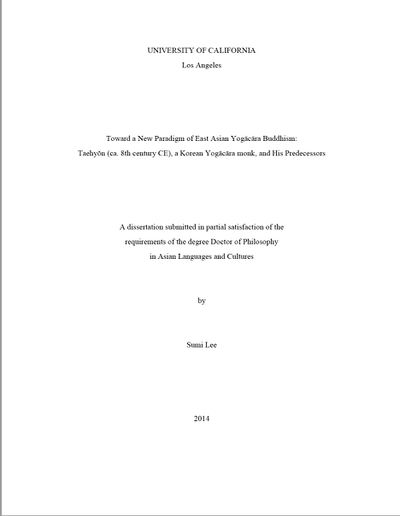Toward a New Paradigm of East Asian Yogācāra Buddhism: Taehyŏn (ca. 8th Century CE), a Korean Yogācāra Monk, and His Predecessors
< Books(Redirected from Toward a New Paradigm of East Asian Yogācāra Buddhism: Taehyŏn (ca. 8th Century CE), a Korean Yogācāra Monk, and His Predecessors)
Abstract
This dissertation seeks to locate the place of Taehyŏn 大賢(ca. 8th century CE), a Silla Korean Yogācāra monk, within the broader East Asian Buddhist tradition. My task is not confined solely to a narrow study of Taehyŏn’s thought and career, but is principally concerned with understanding the wider contours of the East Asian Yogācāra tradition itself and how these contours are reflected in Taehyŏn’s extant oeuvre. There are problems in determining Taehyŏn's doctrinal position within the traditional paradigms of East Asian Yogācāra tradition, that is, the bifurcations of Tathāgatagarbha and Yogācāra; Old and New Yogācāra; the One Vehicle and Three Vehicles; and the Dharma Nature and Dharma Characteristics schools. Taehyŏn's extant works contain doctrines drawn from across these various divides, and his doctrinal positions therefore do not precisely fit any of these traditional paradigms. In order to address this issue, this dissertation examines how these bifurcations originated and evolved over time, across the geographical expanse of the East Asian Yogācāra tradition. The chapters of the dissertation discuss in largely chronological order the theoretical problems involved in these bifurcations within Yogācāra and proposes possible resolutions to these problems, by focusing on the works of such major Buddhist exegetes as Paramārtha (499-569), Ji 基 (632-682), Wŏnhyo 元曉 (617-686), Fazang 法藏(643-712), and, finally, Taehyŏn.
| Citation | Lee, Sumi. "Toward a New Paradigm of East Asian Yogācāra Buddhism: Taehyŏn (ca. 8th Century CE), a Korean Yogācāra Monk, and His Predecessors." PhD diss., University of California, Los Angeles, 2014. https://escholarship.org/uc/item/74h5d0nv#main. |
|---|---|

